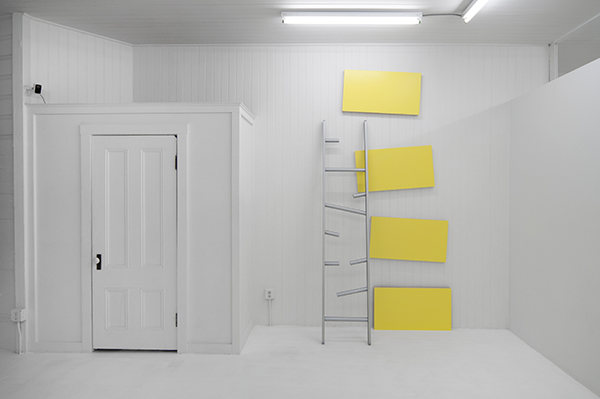
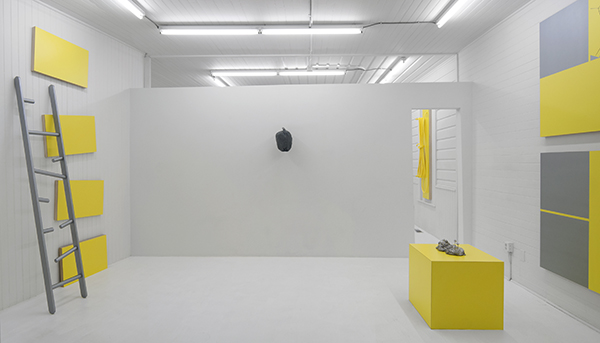


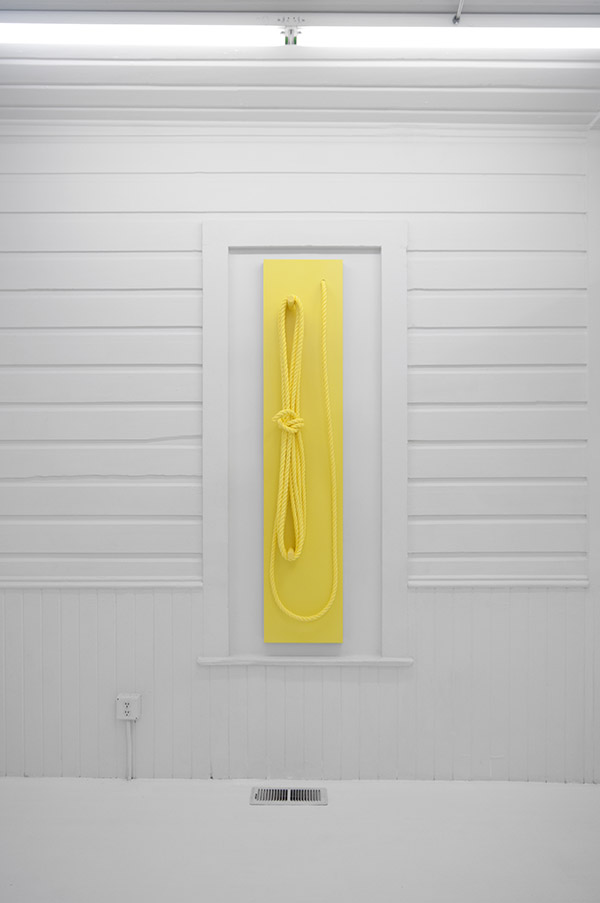

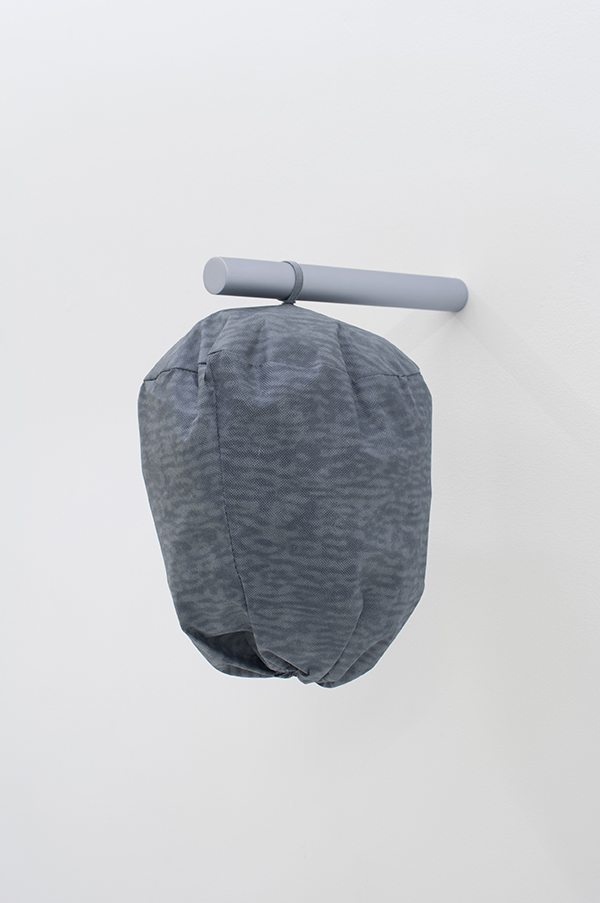
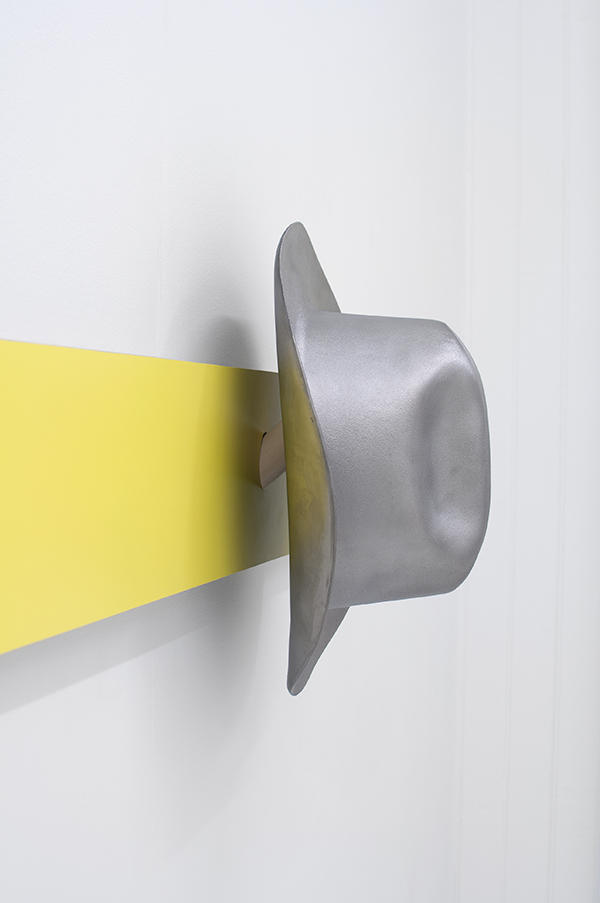
Donald Morgan
High Noon
October 17–November 16, 2015
Having recently completed a residency at the UCross Foundation in northeastern Wyoming, Donald Morgan presents High Noon as a meditation on the western genre. Acting largely in response to the 1994 postmodern western novel Ghost Town by Robert Coover, Morgan presents a collection of pieces informed by the dangers that plague the literary trope of the cowboy hero. Just as Coover’s novel plays with conventions of the western, providing a disjointed, hallucinogenic picture of a cowboy’s journey through a threatening western landscape, Morgan re-works certain tropes of the west, paring them down to their purest signifiers, and displays them as off-kilter paintings, sculptures, and cast objects.
Morgan’s hard edge, reductive geometric pieces recall his art historical forbearers as he continues his aberrant dialogue with artists such as Donald Judd, John McCracken and Richard Artschwager (along with Morgan, many of his influences have a connection to the west – e.g. Judd in Marfa and McCracken in New Mexico). Created in Morgan’s graphic minimal style, paintings that read as broken windows reform the gallery as a place redolent of ghost towns, or the scene of a classic shoot out. Other works in High Noon are made up of elements appearing to be of bad or questionable luck: fabric wasps nests, an almost black cat gazing intently out of a painting at the viewer, a vibrant yellow noose. Each seems laden with threat.
There is also an indeterminacy at work in some of the pieces; the fabric wasps nests are found objects, intended to ward of wasps, and the cat is a gray positioned this side of black. Similarly, the stainless steel hard-hat cowboy hat functions both as a protective device and highly aesthetic object, its silvery hue occupying the slippery middle ground of the white hat=good guy/black hat=bad guy binary. With the hat, instead of suggesting the classic Indian fighter of western lore, bravely fulfilling the promises of manifest destiny, Morgan implies a more complex character, a kind of worried dandy, partial to aesthetics.
Central to the show is a stainless steel cow pie with mushrooms growing from its metallic form, implying not just a trip that could go either way, but providing a concrete representation of the psychedelic aura of the show. Recasting the other objects under it’s hallucinogenic guise, Morgan’s mushroom cow pie draws attention to our potentially distorted perception of the western genre in an age where the cowboy is absent from everyday metropolitan life except as a mythic figure.
As a collection of objects, High Noon propels viewers into a space where the threat of bodily harm is present yet ambiguous; never truly manifesting. As the viewer is invited to take on the imaginary role of a cowboy, one is also presented with an aesthetically rendered picture of the west, allowing Morgan’s highly stylized, playful re-workings of the genre to permeate.
High Noon
October 17–November 16, 2015
Having recently completed a residency at the UCross Foundation in northeastern Wyoming, Donald Morgan presents High Noon as a meditation on the western genre. Acting largely in response to the 1994 postmodern western novel Ghost Town by Robert Coover, Morgan presents a collection of pieces informed by the dangers that plague the literary trope of the cowboy hero. Just as Coover’s novel plays with conventions of the western, providing a disjointed, hallucinogenic picture of a cowboy’s journey through a threatening western landscape, Morgan re-works certain tropes of the west, paring them down to their purest signifiers, and displays them as off-kilter paintings, sculptures, and cast objects.
Morgan’s hard edge, reductive geometric pieces recall his art historical forbearers as he continues his aberrant dialogue with artists such as Donald Judd, John McCracken and Richard Artschwager (along with Morgan, many of his influences have a connection to the west – e.g. Judd in Marfa and McCracken in New Mexico). Created in Morgan’s graphic minimal style, paintings that read as broken windows reform the gallery as a place redolent of ghost towns, or the scene of a classic shoot out. Other works in High Noon are made up of elements appearing to be of bad or questionable luck: fabric wasps nests, an almost black cat gazing intently out of a painting at the viewer, a vibrant yellow noose. Each seems laden with threat.
There is also an indeterminacy at work in some of the pieces; the fabric wasps nests are found objects, intended to ward of wasps, and the cat is a gray positioned this side of black. Similarly, the stainless steel hard-hat cowboy hat functions both as a protective device and highly aesthetic object, its silvery hue occupying the slippery middle ground of the white hat=good guy/black hat=bad guy binary. With the hat, instead of suggesting the classic Indian fighter of western lore, bravely fulfilling the promises of manifest destiny, Morgan implies a more complex character, a kind of worried dandy, partial to aesthetics.
Central to the show is a stainless steel cow pie with mushrooms growing from its metallic form, implying not just a trip that could go either way, but providing a concrete representation of the psychedelic aura of the show. Recasting the other objects under it’s hallucinogenic guise, Morgan’s mushroom cow pie draws attention to our potentially distorted perception of the western genre in an age where the cowboy is absent from everyday metropolitan life except as a mythic figure.
As a collection of objects, High Noon propels viewers into a space where the threat of bodily harm is present yet ambiguous; never truly manifesting. As the viewer is invited to take on the imaginary role of a cowboy, one is also presented with an aesthetically rendered picture of the west, allowing Morgan’s highly stylized, playful re-workings of the genre to permeate.